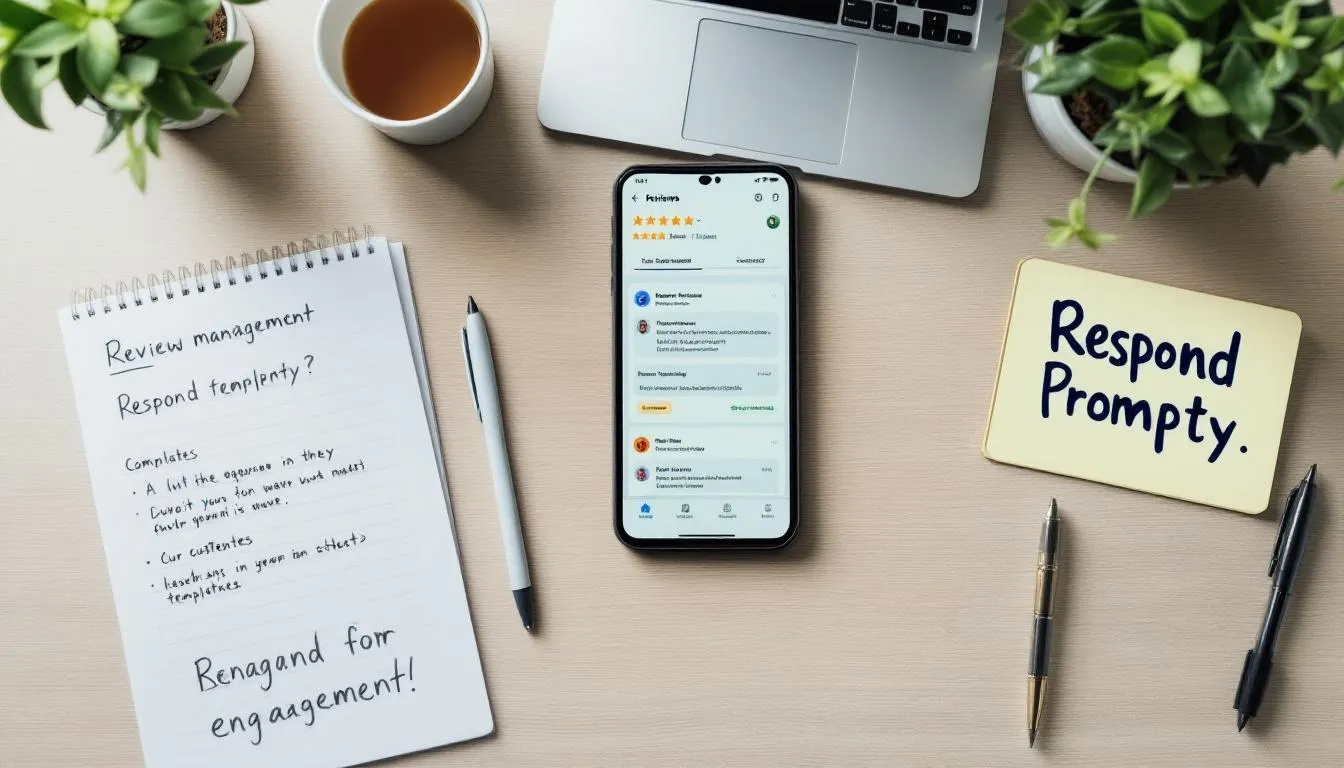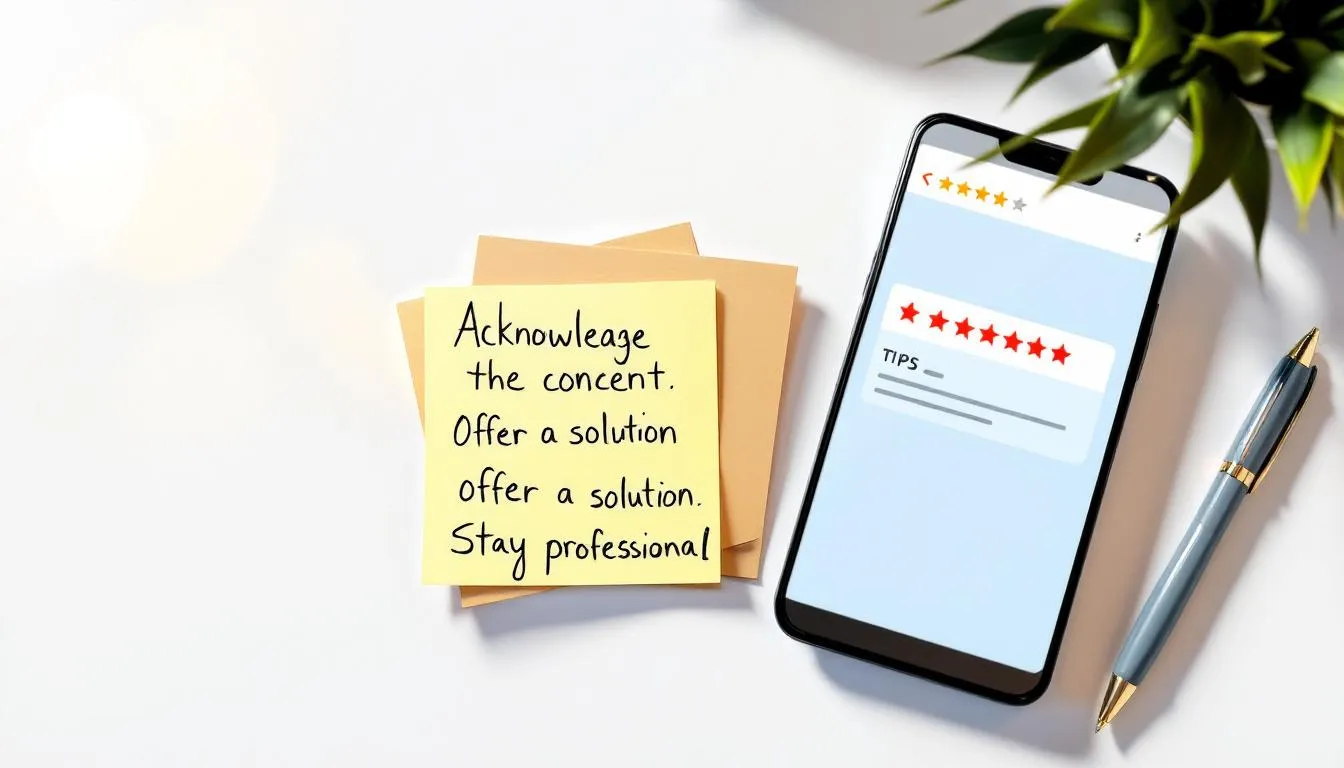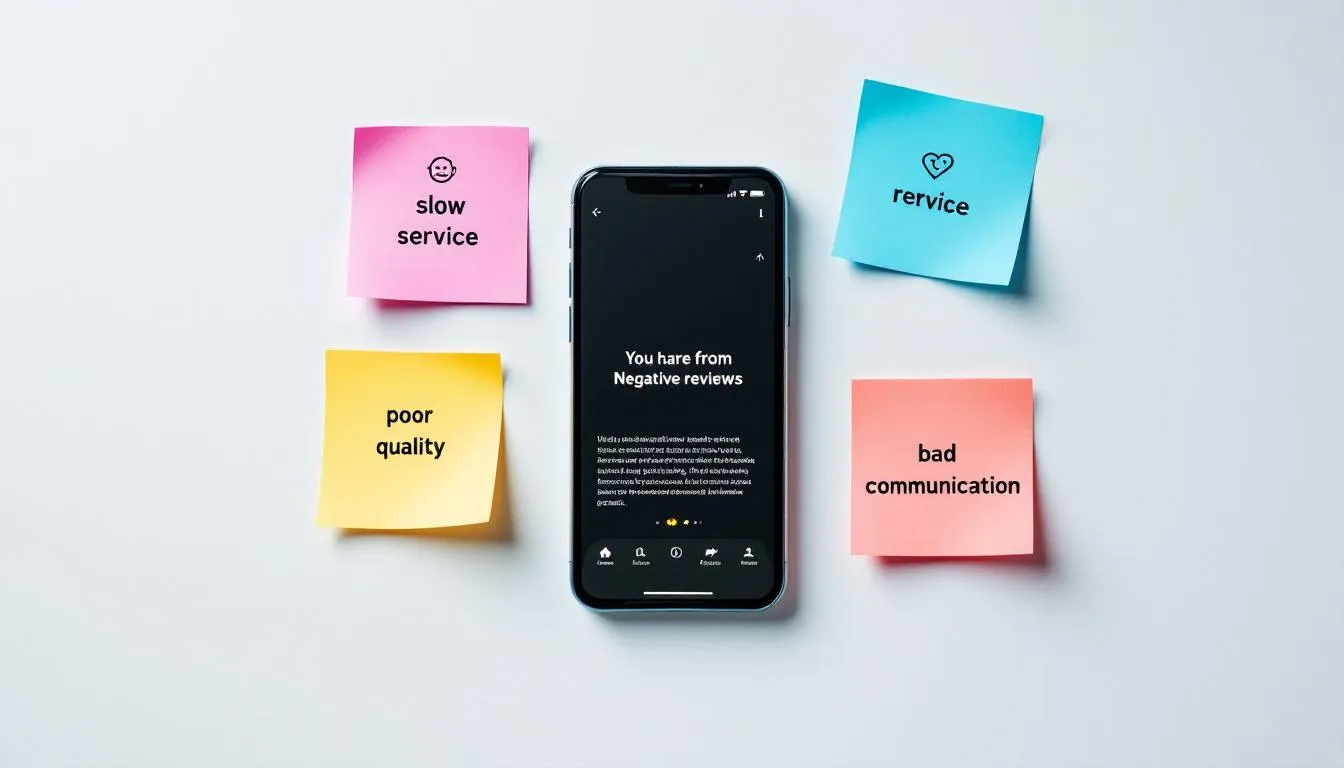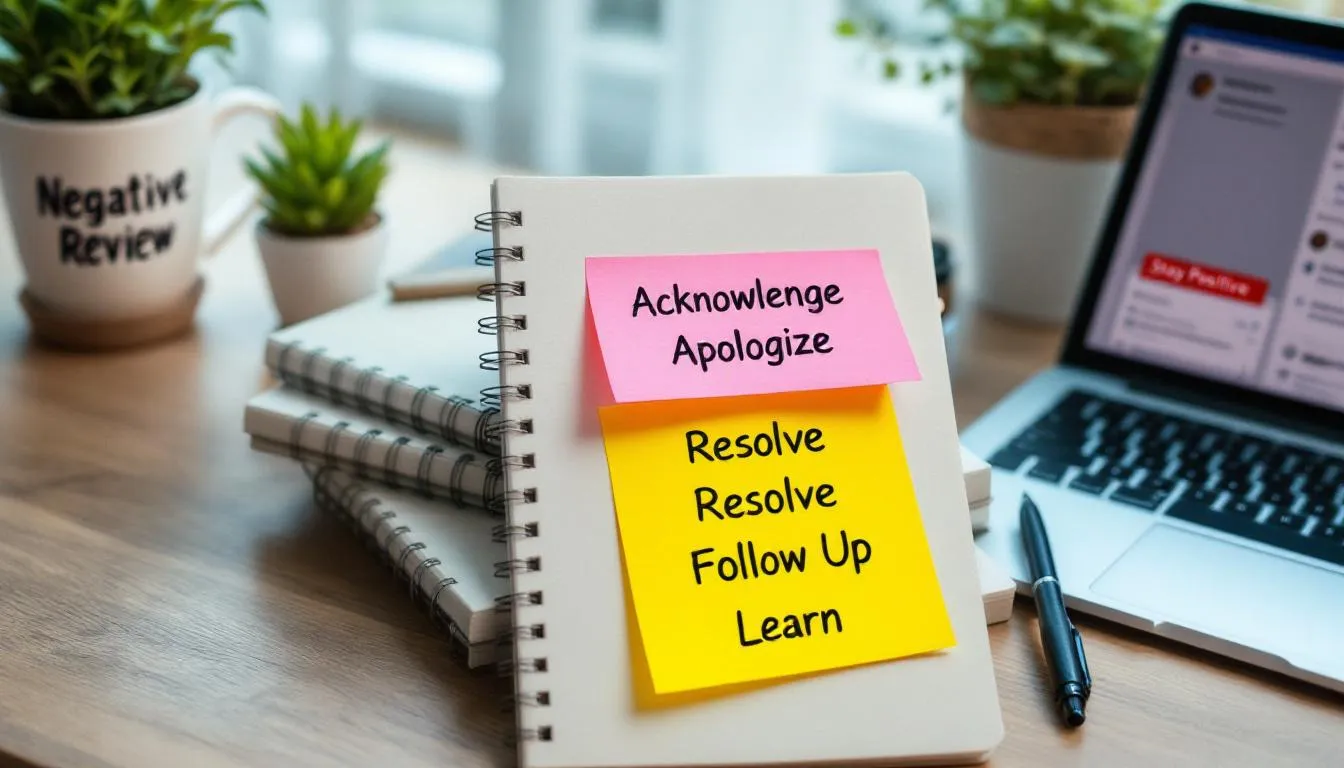
Wondering how to reply to a negative Google review? This guide offers practical tips to help you respond effectively. Learn how to craft responses that show empathy, address concerns, and rebuild trust with your customers.

Negative reviews can have a strong negative impact on consumers and significantly damage brand image, affecting potential sales opportunities. Key points to consider include:
Negative reviews highlight areas for improvement, allowing businesses to address weaknesses. Responding to reviews encourages customer engagement and demonstrates that a business values customer feedback. Businesses can see positive impacts on sales by actively responding to customer reviews. Addressing negative feedback on Google is significant for maintaining an online reputation and building customer trust.
Responding professionally and with empathy can demonstrate attentiveness and care about customers, which can help restore trust. A professional response to a negative review reflects positively on the business, showing that they are committed to resolving issues. Ignoring negative reviews hurts a brand’s reputation by signaling a lack of care toward customers. Online reviews can shape customer perceptions significantly, influencing decision-making and brand trust.
Engaging with negative reviewers not only showcases your commitment to customer satisfaction but also provides a platform for an engaged business owner to turn a dissatisfied customer into a loyal one. Acknowledging and addressing customer concerns not only improves your business but also shows that feedback is integral to your continuous improvement, ultimately helping to reduce the number of dissatisfied customers.
Responding to negative Google reviews is crucial as it protects your reputation, builds trust, and improves online visibility. When responding to a negative google review, follow these guidelines:
Crafting thoughtful responses to negative reviews involves several best practices. Firstly, personalizing your response shows that you are genuinely engaged with the customer’s feedback. Expressing gratitude for their input highlights that you value their opinion and are committed to providing exceptional service. Additionally, it is essential to craft responses that address the specific concerns raised by the customer.
Lastly, a sincere apology can go a long way in mending the relationship and restoring trust.
Personalizing responses to negative reviews shows engagement and care for customers, which can enhance trust. Personalized responses ensure that each reply is unique and aligned with customer feedback. Addressing the reviewer by name makes the interaction more personal and shows that you value their feedback. Using the reviewer’s name in responses increases the feeling of personalization and engagement.
Beginning your response with the reviewer’s name can create a welcoming and sensitive tone. Incorporating the reviewer’s name at the start of your response sets a positive tone for the interaction. Crafting a personalized response involves acknowledging the customer’s unique experience and addressing their comments thoughtfully.
Dear customer, starting your response with “Dear [Customer’s Name],” followed by an acknowledgment of their specific concerns, can make a significant difference. This approach not only shows that you’re paying attention but also that you are committed to resolving their issues in a personalized manner. This level of engagement can significantly improve customer satisfaction and loyalty.
Thanking customers for their feedback:
A recommended practice for acknowledging negative reviews includes thanking customers for their feedback to avoid negative reviews and encouraging new reviews, which can lead to more reviews and a positive review.
Always thank the reviewer for their feedback in your response. Key elements to include in your response to a negative review is thanking the reviewer for their feedback. An example of thanking a reviewer for their feedback could be: “Thank you for your review. I’m sorry to hear you had a frustrating experience.” A business should acknowledge a customer’s feedback by thanking the reviewer.
An appropriate closing statement in a response to a negative review could be: “Thanks again for leaving a review, and hope to hear from you soon.” Expressing gratitude not only shows that you value their input but also sets a positive tone for future interactions. This practice can help build goodwill and demonstrate your commitment to providing exceptional service. Using a negative review response template can further enhance your approach.
Apologizing to a dissatisfied customer acknowledges their negative experience and conveys empathy, even if the business is not at fault. An effective apology should acknowledge the issue, express regret for the negative experience, and invite discussion for improvement. Keep the tone of the apology short and sweet, expressing genuine sentiment without being defensive.
A genuine apology can strengthen trust and enhance the overall relationship between the business and the customer. For instance, starting your apology with “We’re sorry to hear about your experience” can show that you genuinely care about their concerns. This approach not only helps in mending the relationship but also demonstrates your commitment to improving your services based on customer feedback.

Addressing specific concerns in a review response shows that a business values review feedback and is committed to improvement. For instance, if a hotel guest complains about cleanliness issues, acknowledging this feedback and assuring them that steps will be taken to improve can foster reviews support trust building.
Providing a clear plan for improvement in response to a negative review can rebuild trust with customers. For example, stating that you will be retraining staff or implementing new cleaning protocols shows commitment to addressing the issue. Clarifying how issues raised in a review will be tackled can foster trust and demonstrate a commitment to improvement.
Willingness to resolve issues can turn a negative review into a more positive perception. Responses should include specific details about the customer’s experience and any changes implemented based on their feedback. This level of detail shows that the feedback was fully considered and that the business is taking concrete steps to improve.
Empathetic responses that directly address concerns can help to positively shift a customer’s perception. For negative reviews that mention systemic problems, organizations should focus on correcting the underlying issues. This approach not only addresses the immediate concern but also demonstrates a long-term commitment to quality and customer satisfaction.
Offering a solution is key to remedying the customer’s issue effectively. For example, if a loyal customer complains about a faulty product, offering a replacement or a refund shows that you are committed to resolving the issue. Encouraging return visits demonstrates a commitment to provide exceptional customer service and improving the customer experience.
Invite the reviewer to contact you directly for further assistance, including providing your contact details. This approach:
Offering solutions and next steps is not just about fixing the immediate problem but also about showing a long-term commitment to customer satisfaction. For example, if a restaurant patron complains about cold food, a business owner could offer a complimentary meal on their next visit and assure them that steps are being taken to ensure food is served hot in the future.
Encouraging return visits and providing direct contact details demonstrate a commitment to improving the customer experience. This approach not only resolves the immediate issue but also builds a foundation for future positive interactions and customer loyalty.
Quickly responding to negative reviews maintains a positive reputation and builds customer trust. Guests who feel heard can become strong advocates for the business, reinforcing the need for timely replies. Responding to reviews promptly shows attentiveness and prevents the escalation of issues.
The ideal time frame for responding to negative reviews is within 48 hours, preferably within 24 hours. This quick response speed shows that you are actively monitoring feedback and are committed to resolving issues promptly. Businesses can set up alerts to be notified when a bad review comes in to facilitate swift responses.
Responding on the same platform where the review was posted ensures transparency and accountability. This practice not only shows that you are addressing the review publicly but also provides potential customers with a clear view of how you handle negative feedback. Quick responses build trust, customer loyalty, and show that the business values feedback.
Timely responses can turn a potentially negative situation into a positive one by showing that you care about your customers’ experiences and are committed to promptly responding to making things right in a timely manner. This approach not only resolves the immediate issue but also builds a foundation for long-term positive customer relationships.

Providing specific examples of effective responses helps businesses illustrate best practices for addressing negative reviews. Many brands use tailored responses to win back unhappy customers. Examples of negative review responses demonstrate the effective implementation of industry best practices.
Free response templates for various industries streamline the process of crafting replies. Prompt response templates can help businesses respond more quickly and overcome writer’s block, leading to timely customer interactions. By examining examples across different industries, businesses can gain insights into how to handle various types of negative feedback effectively.
Tailored responses address specific issues and show a genuine commitment to customer satisfaction. Let’s explore some examples from different industries to see these best practices in action.
A well-crafted response to a negative restaurant review showcases empathy, acknowledgment, and offers a resolution. Maintaining a polite and professional manner in the response is crucial to uphold the restaurant’s reputation. For instance, if a reviewer mentions issues with odor, a lack of cleanliness, overcrowding, and cold food, these concerns need to be addressed directly.
An effective response might start with: “Dear [Customer’s Name], thank you for sharing your feedback. We are sorry to hear about your experience with the odor and lack of cleanliness.” This shows that you are listening and value their input.
Outlining plans for improvement demonstrates commitment to quality service: “We are reviewing our cleaning protocols to ensure our staff is more attentive to these details in the future.” Inviting the customer back for a complimentary service can turn their negative experience into a positive one: “We would like to invite you back for a complimentary meal to experience the improvements we are making.”
A well-crafted thoughtful response like this not only addresses the specific concerns raised but also shows a genuine commitment to providing excellent service and exceptional customer service. This can help rebuild trust and encourage the reviewer to give your restaurant another chance.
An effective response to a guest complaining about an overbooked hotel room should include:
Acknowledge the feedback and outline plans for improvement: “We understand how frustrating this must have been, and we are taking steps to ensure this does not happen again. We are reviewing our booking process to prevent overbookings in the future.” This shows that you are committed to improving your services based on the feedback received.
Invite the reviewer to reach out for further assistance: “Please contact us directly at [contact information] so we can assist you further and ensure a more pleasant further resolution on your next visit.” This approach not only addresses the immediate issue but also provides an opportunity for a more personalized resolution.
A well-crafted response reassures future guests that their concerns will be taken seriously and addressed promptly. This approach can help support trust building and encourage more positive reviews.
Acknowledge the inaccuracies in the review and assure the reviewer that the issue will be investigated. For example, if a customer complains about inaccuracies in the product description, an effective response might be: “Dear [Customer’s Name], thank you for bringing this to our attention. We apologize for any confusion caused by the product description.”
Address complaints about slow delivery: “We understand your frustration with the delayed delivery and are working to expedite our shipping process to ensure timely deliveries in the future. This customer complaint shows that you are taking steps to improve your services based on the feedback received.”
We apologize for the lack of communication and are here to assist you with any further concerns, including the opportunity for a conversation offline. Please contact us directly at [contact information]. This approach not only addresses the immediate issue but also provides an opportunity for a more personalized resolution.
A well-crafted response impacts potential customers’ perceptions: “Your user feedback is valuable feedback to us, and we are committed to enhancing customer satisfaction and improving our products and services based on your customer’s experience and customers feedback.” This approach can help build trust and encourage more positive reviews.

When managing customer feedback, avoid the following practices:
Lack of accountability can negatively impact customer’s negative experience, trust, and perception of the brand. Defensive or argumentative responses can alienate the reviewer and potential customers observing the interaction. Complicated responses can confuse customers and dilute the main message, leading to bad customer service.
To ensure your responses are effective in maintaining customer satisfaction and improving your online reputation, avoid these mistakes by:
By doing so, you turn negative feedback and positive feedback into an opportunity for growth and improvement, addressing negative customer feedback effectively.
Responding to negative reviews can significantly improve consumer perceptions and encourage potential customers to choose your business. Quick responses maintain a positive brand image among current and prospective customers. To effectively respond to negative reviews can significantly improve overall ratings.
Expressing gratitude helps build goodwill and shows a willingness to improve. Thanking guests for their reviews demonstrates professionalism and a willingness to improve. Adopting a humble attitude and focusing on solutions rather than defensiveness can encourage positive reviews.
Apologizing to customers shows care, establishes trust, and demonstrates humility. The purpose of apologizing is to express regret for the customer’s distress or inconvenience and to maintain service standards. Proactively offering solutions to negative feedback can enhance customer loyalty.
Following up on a resolved issue reinforces customer care and influences future interactions positively, leading to positive outcomes. Consistently demonstrating your commitment to customer satisfaction encourages more positive reviews and builds a strong online reputation.
Online reputation management software helps brands oversee and enhance their online reputation by tracking comments and reviews across various media. Platforms like:
Podium facilitates customer review management while also supporting communication and payment processes for local businesses. A review site can automate notifications for positive experiences, encouraging customers to share their feedback online.
The text describes the following services and features:
Managing online reviews is crucial for businesses as they directly impact reputation and customer trust, and various tools facilitate this process, including review sites. By leveraging these tools, businesses can ensure timely and effective responses to reviews, ultimately enhancing their online presence and customer satisfaction.
In summary, responding to negative Google reviews is not just about damage control but an opportunity to demonstrate your commitment to customer satisfaction and improvement. By addressing negative feedback thoughtfully and promptly, you can turn potentially harmful situations into opportunities for growth and positive customer engagement.
We have discussed the best practices for crafting effective responses, including personalizing your responses, expressing gratitude, and offering sincere apologies. Additionally, providing specific examples from various industries can help illustrate these practices in action, showing how thoughtful responses can transform negative experiences into positive outcomes.
By avoiding common mistakes and leveraging tools for managing online reviews, businesses can maintain a strong online reputation and build trust with their customers. Embracing these strategies and tools will not only help you manage negative reviews effectively but also encourage more positive reviews, ultimately enhancing your business’s overall ratings and customer loyalty.
Responding to negative Google reviews is essential as it protects your reputation and fosters trust with potential customers. By addressing concerns, you demonstrate your commitment to customer satisfaction, which can enhance your business's online presence.
To effectively address a negative review, personalize your response and maintain a courteous tone while acknowledging the feedback and offering a sincere apology. Always conclude by expressing gratitude and providing contact information for further communication.
To effectively personalize your responses to negative reviews, address the reviewer by name, acknowledge their specific concerns, and express appreciation for their feedback. This fosters trust and demonstrates that you genuinely care about their experience.
Avoid delaying your response and using generic replies, as these can make the situation worse. Instead, respond promptly with empathy and accountability, targeting specific issues to demonstrate your commitment to resolution.
To encourage positive reviews, respond promptly to negative feedback and express gratitude while resolving issues. Consistently demonstrating your commitment to customer satisfaction will inspire more favorable reviews.
Learn how to enhance your online presence, gather more positive reviews, and prevent negative feedback.




Why waste time managing reviews manually? Let ReviewCrusher AI do the heavy lifting for you!
With our AI-powered tool, you can boost your reputation, attract more customers, and grow your business—effortlessly. We automate the tasks that matter most, so you can focus on what you do best.
🚀 More trust. More sales. Less hassle.
This is your chance to see how ReviewCrusher AI can transform your online presence and deliver real results.
Ready to take your business to the next level?
Click below to sign up now and start crushing your goals today! 💪